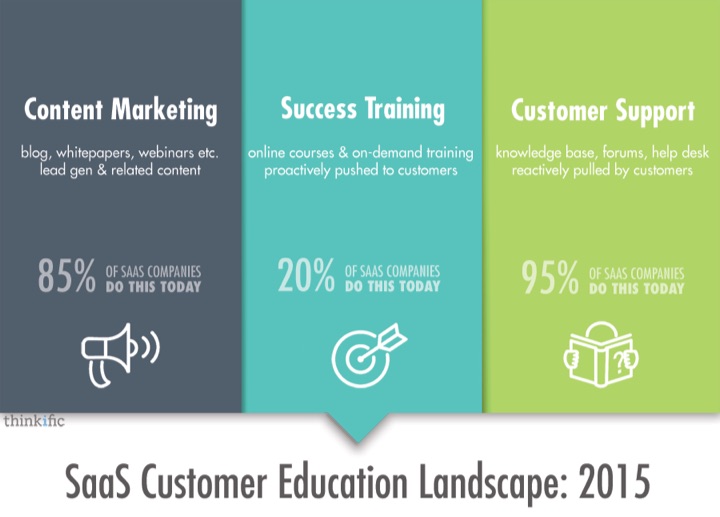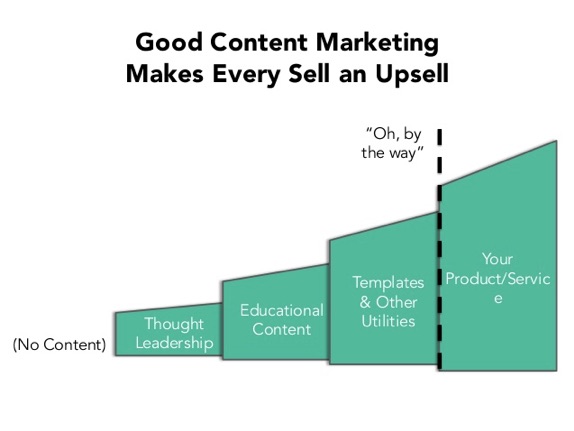Marketo, the lead nurturing platform, is one of the best tools for marketers to create long-term relationships with customers, from creating prospects to converting them into advocates.
This “lead nurturing” is a proven tactic for moving prospects through a marketing funnel and improving customer engagement. For a SaaS business, which can oftentimes rely on personalized demos or free trials for prospects, nurturing can be a critical component of the marketing strategy. Considering that 40-60% of free trial users will never become paying users, it is especially important to use nurturing to educate and engage your prospects through content, as well as to ensure they understand the value of becoming a loyal, paying customer.
First Lesson: Nurture with Educational Content
Whereas traditional businesses make a sale once a prospective customer converts, SaaS businesses rely on the success of software free trials, creating a higher-risk, higher-touch relationship with leads who haven’t converted into paying users.
Baremetrics used educational content and other tactics to reduce churn by 63%.

But a lot of times, after bringing prospects into the funnel using educational and organic content, you may find yourself wondering: where are the conversions? When does the magic start to happen?
Second Lesson: Middle-of-the-Funnel Advantage
Because of the nature of the SaaS business model, there is a low barrier of entry for prospects. A common conversion point for many SaaS is a freemium model as it allows users to “try before they buy” into a subscription. Trouble is, once the user has already provided their contact info, the clock starts ticking. Unless your product is capable of selling itself, you’re going to need informational and promotional content to convince trial users to convert to paying users.
Because of the number of prospects and opportunities in the middle of the funnel, SaaS businesses are forced to segment users on more than a demographic score but also on a behavioral score. This is the activity your users have taken to get to the point where they are now.
Nurturing users who are in your free trial is a great way to test the effectiveness of your educational content. If more users convert after being delivered targeted messaging, Marketo is smart enough to convey similar content, a technique called Content Personalization.
These middle-of-the-funnel nurture campaigns can help your prospects stay enthralled during the trial; they can also assist with the final conversion point: your product or service.

First-touch attribution is the crux of any SaaS marketing analytics effort. Understanding where your customers are coming from and how to pour gasoline on that fire is the surest way to scale growth. Marketo does this well. Every user that comes onto your radar is tracked by IP, even without any other information about that visitor.
However, Marketo is more than an email service and “automation” doesn’t simply mean customers are sent emails. Marketo also has a fantastic analytics feature and numerous integrations which can greatly improve every facet of your marketing process.
Consider These Implications
TRACK REPEATED USE
You cannot be passive and let free trial users sit idly by. Engaging and educating prospects should be a priority. Encouraging feedback and actual conversations with your customers is the only way you’re going to make those relationship real. Thus, a metric for your software should be repeated use from nurtured users. There are a number of in-app integrations that can assist with this, but a simple one is Google Analytics. Set up a custom property to track users who are using your service. A more robust option is Kissmetrics.
SYNC WITH CRM
A database sync to Salesforce or another CRM is critical, so come into the process with a clean database in hand, or face the consequences. Your CRM will sync with Marketo and send data back and forth. Any mistake you make with Marketo will reveal itself on the CRM side. Unless you’re a professional Salesforce Architect, be careful not to ruin years of work. You also certainly don’t want to upset your sales team.
CUSTOMER-FIRST, FIRST
You’ll need to sharpen your understanding of your customer base. Collecting emails for anyone who enters your funnel doesn’t help you nurture, so identify a way to segment prospects during the conversion. A great example of this is to invite your newsletter list to download an industry-specific ebook or white paper. If they take the (free) bait, then you know they are interested in that content. If you think you need 13 points of personal data to close a sale, try to figure out a way to get one or two more pieces of data every time you communicate with your audience. Develop your nurture campaign after you’ve defined your ideal customer.
Third Lesson: Develop a Roadmap
Your roadmap should be customer-focused, which should be second-nature to any successful SaaS. Customers are interacting with your Marketo implementation just as much as your marketing team.
Make sure you include reporting in your roadmap. A solid reporting framework will take some time to set up. To avoid common first-timer mistakes, include a simple report in every smart campaign you set up, the first time you set it up. You can always improve the report and identify your stakeholders later on at the reporting level, but going through every active campaign and checking the flow will save you a few hours of work later on.
Another good tip is to group alerts together using smart lists. Once a person (what a lead is called in Marketo) reaches qualification, ensure the right alert is triggered. Set up SQL alerts, MQL alerts, and a General alert, making sure the proper stakeholders are notified.
Lead scoring is the foundation of Marketo. Decide, with your sales team, how to establish a behavioral sales-qualified lead and a marketing-qualified lead. From there, develop your marketing-qualified leads as a ramp-up to the SQL.
You can add layers of personalization to every brand message you send your audience.
Setting Expectations, Managing Up and Down
You won’t find a perfect solution, but the advantage of Marketo is the numerous integrations with third-party solutions that can help. Direct third-party integrations with Marketo can be found at launchpoint.marketo.com, so if your SaaS relies on one specific tool, you may want to check there first and see if it is available.
Software solutions are rarely “turned on with the flick of a switch.” Make sure your executive team is aware of the scope and timeline of a marketing automation integration.
If your SaaS is currently using automation, a realistic time frame for moving to Marketo is 3 months.
If you’ve never used automation, expect it to take 6 months. Even then, marketing automation is an endeavor which may take years to master.
Something will inevitably break: your API, your CRM sync, your nurture streams, or a webhook. By anticipating the disconnect, you can implement redundancies.
Fourth Lesson: Start With a Phased Implementation
Don’t sync with your CRM on the first day. In fact, you may not want to sync with your CRM at all. Once you’ve synced to Marketo, there is no turning back. To implement this properly, start on-site with the Munchkin code, and split-test some leads with a Marketo form. These are your guinea pigs. As leads are added to your Marketo database, you’ll be to able to see just how much power the software has.
Establish a pilot program, literally. Draw a line in the sand and announce to all stakeholders about the new automation program and be sure they understand the implications. Your sales team, your management, your social media agency, etc. Make sure they understand how the leads are different and what the expected outcome is.
Once you have a successful pilot program, move your newsletters and landing pages to Marketo. Use Marketo’s A/B testing to ensure your copy and visuals haven’t impacted conversions.
Finally, take the plunge. Sync your CRM. Drive traffic with email blasts, re-qualify old leads in your database, and add customers that have re-engaged to your nurture campaigns.
Set up reporting and make sure stakeholders understand the data. Not all CRM data will align with Marketo, so if there is a discrepancy, choose one reporting engine and stick with it.
Fifth Lesson: Adding Your Favorite Integrations
Chances are, there is a way to integrate Marketo with the tools and processes you are already using. Sometimes, you’ll find an integration at the Launchpoint portal, but if you don’t, there’s a webhook for that. Here are some useful integrations for a SaaS:
SLACK
The Marketo-Slack integration has improved our productivity, reduced emails, and increased response time for customer inquiries. Through the webhook integration, our entire sales team is alerted of our customers and prospects’ interesting moments, demo requests, and free trial conversions. They are able to quickly claim a lead, discuss opportunities and follow up, right in the Marketo channel. Jenna Molby has a fantastic guide for setup, which can be found here.
WORDPRESS
WordPress.org, the open-source publishing platform, is one of the most popular self-hosting options for website and blogs. Due to its low cost and easy customization, it is especially popular amongst the lean startup crowd. While there are some integrations available for Marketo and WordPress, it may be easier for most SaaS companies to use the gravity form add-on and Marketo munchkin code to track visitors on your site.
SUMOME
SumoMe is a suite of lead generation tools designed to grow traffic and increase conversions. It includes a number of pop-ups, pop-overs, slide-ins, and widgets that can improve newsletter subscriptions and social shares. The integration with Marketo is relatively new and the full documentation for integration can be found here.
Conclusion
For a SaaS, the middle of the funnel can be extremely important, especially for businesses with a freemium model. It can keep prospects engaged, educate them, and ensure they get the most out of your software. It can align sales teams and ensure they are receiving the most qualified leads possible based on prospects’ interaction with marketing assets. It can help you reduce churn and improve retention. With a proper setup and numerous integrations, Marketo can communicate with customers at the most opportune moment, and deliver a personalized experience not possible with other automation suites. Integration in your SaaS marketing strategy is worth the effort.
About the Author: Brian Sparker is Head of Content Marketing for ReviewTrackers, a review monitoring and customer feedback platform designed to help companies efficiently monitor online reviews, manage reputation, and enhance the customer experience in ways that make a positive impact on the bottom line.
from The Kissmetrics Marketing Blog https://blog.kissmetrics.com/integrating-marketo-into-saas-marketing/
No comments:
Post a Comment